An Evidence-Based Survey on Full-Scale Membrane Biological Reactors: Main Technical Features and Operational Aspects
Abstract
:1. Introduction
2. Methodology
- location of the plant;
- date of construction;
- type of wastewater treated;
- type of membrane (hollow-fiber, flat-sheet, hybrid);
- organic load (in terms of BOD5 and/or COD);
- average daily flowrate.
- effluent destination and threshold limits;
- treatment chain;
- dimensional and construction characteristics of the MBR section;
- raw wastewater and effluent properties;
- chemicals dosed in the plant;
- reasons that led to the MBR being installed;
- operational advantages obtained thanks to the installation of the MBR;
- operational problems concerning or related to the MBR.
3. Results and Discussion
3.1. MBR Plants in Italy
3.1.1. Number of MBR Plants, Capacity and Location
3.1.2. Year of Construction
3.1.3. Type of Membrane
3.2. Operational Aspects and Judgement of the Plant Managers
3.2.1. Characteristics of the MBR Plants Analyzed
3.2.2. Driving Forces of MBR Installation
3.2.3. Operational Advantages
3.2.4. Critical Operational Aspects
4. Conclusions
- There are about 290 MBR plants in Italy, and they are located mainly in the most industrial area of the country. The number of municipal plants that provided information is 106, and they serve about 2 million PE, corresponding to approximately 3% of the total organic load treated by the Italian WWTPs with secondary and advanced treatments;
- Flat-sheet membranes are more spread than hollow-fiber ones, above all in small installations. In the case of hollow-fiber membranes, high area per unit volume, cost effective fabrication process, and capability to withstand severe operating conditions make them attractive. Recently, hybrid membranes were utilized in few plants;
- The main drivers for the installation of the MBR system are the lack of space and the necessity to increase the treatment capacity of existing plants, both in the case of industrial and municipal wastewater;
- The opinion of the plant managers is substantially positive. In particular, the reliability in the compliance with the discharge limits, the improvement of the plant capacity and, above all, in the industrial installations and the automation of the process are very appreciated features. However, some critical aspects remain, such as membrane fouling and plant shutdown, on which the MBR technology producers are required to give effective answers.
Supplementary Materials
Author Contributions
Funding
Institutional Review Board Statement
Informed Consent Statement
Data Availability Statement
Acknowledgments
Conflicts of Interest
References
- Meng, F.; Chae, S.R.; Drews, A.; Kraume, M.; Shin, H.-S.; Yang, F. Recent advances in membrane bioreactors (MBRs): Membrane fouling and membrane material. Water Res. 2009, 43, 1489–1512. [Google Scholar] [CrossRef] [PubMed]
- Judd, S.; Judd, C. The MBR Book: Principles and Applications of Membrane Bioreactors for Water and Wastewater Treatment, 2nd ed.; Elsevier: Oxford, UK, 2011. [Google Scholar]
- Wang, Z.; Ma, J.; Tang, C.Y.; Kimura, K.; Wang, Q.; Han, X. Membrane cleaning in membrane bioreactors: A review. J. Membr. Sci. 2014, 468, 276–307. [Google Scholar] [CrossRef]
- Krzeminski, P.; Leverette, L.; Malamis, S.; Katsou, E. Membrane bioreactors—A review on recent developments in energy reduction, fouling control, novel configurations, LCA and market prospects. J. Membr. Sci. 2017, 527, 207–227. [Google Scholar] [CrossRef] [Green Version]
- Meng, F.; Zhang, S.; Oh, Y.; Zhou, Z.; Shin, H.-S.; Chae, S.-R. Fouling in membrane bioreactors: An updated review. Water Res. 2017, 114, 151–180. [Google Scholar] [CrossRef] [PubMed]
- Yoon, S.-H.; Kim, H.-S.; Yeom, I.-T. The optimum operational condition of membrane bioreactor (MBR): Cost estimation of aeration and sludge treatment. Water Res. 2004, 38, 37–46. [Google Scholar] [CrossRef] [PubMed]
- Bertanza, G.; Canato, M.; Laera, G.; Vaccari, M.; Svanström, M.; Heimersson, S. A comparison between two full-scale MBR and CAS municipal wastewater treatment plants: Techno-economic-environmental assessment. Environ. Sci. Pollut. Res. 2017, 24, 17383–17393. [Google Scholar] [CrossRef] [Green Version]
- Hamedi, H.; Ehteshami, M.; Mirbagheri, S.A.; Rasouli, S.A.; Zendehboudi, S. Current Status and Future Prospects of Membrane Bioreactors (MBRs) and Fouling Phenomena: A Systematic Review. Can. J. Chem. Eng. 2019, 97, 32–58. [Google Scholar] [CrossRef] [Green Version]
- Iorhemen, O.T.; Hamza, R.A.; Tay, J.H. Membrane Bioreactor (MBR) Technology for Wastewater Treatment and Reclamation: Membrane Fouling. Membranes 2016, 6, 33. [Google Scholar] [CrossRef] [Green Version]
- Musa, M.A.; Idrus, S.; Che Man, H.; Nik Daud, N.N. Wastewater Treatment and Biogas Recovery Using Anaerobic Membrane Bioreactors (AnMBRs): Strategies and Achievements. Energies 2018, 11, 1675. [Google Scholar] [CrossRef] [Green Version]
- Collivignarelli, M.C.; Abbà, A.; Bertanza, G.; Setti, M.; Barbieri, G.; Frattarola, A. Integrating novel (thermophilic aerobic membrane reactor-TAMR) and conventional (conventional activated sludge-CAS) biological processes for the treatment of high strength aqueous wastes. Bioresour. Technol. 2018, 255, 213–219. [Google Scholar] [CrossRef]
- Collivignarelli, M.C.; Abbà, A.; Frattarola, A.; Manenti, S.; Todeschini, S.; Bertanza, G.; Pedrazzani, R. Treatment of aqueous wastes by means of Thermophilic Aerobic Membrane Reactor (TAMR) and nanofiltration (NF): Process auditing of a full-scale plant. Environ. Monit. Assess. 2019, 191, 708. [Google Scholar] [CrossRef] [PubMed]
- Collivignarelli, M.C.; Abbà, A.; Castagnola, F.; Bertanza, G. Minimization of municipal sewage sludge by means of a thermophilic membrane bioreactor with intermittent aeration. J. Clean. Prod. 2017, 143, 369–376. [Google Scholar] [CrossRef]
- Collivignarelli, M.C.; Abbà, A.; Bertanza, G.; Frattarola, A. The upgrading of conventional activated sludge processes with thermophilic aerobic membrane reactor: Alternative solutions for sludge reduction. J. Environ. Manag. 2020, 264, 110490. [Google Scholar] [CrossRef] [PubMed]
- Hai, F.I.; Yamamoto, K.; Lee, C.-H. Membrane Biological Reactors: Theory, Modeling, Design, Management and Applications to Wastewater Reuse, 2nd ed.; IWA Publishing: London, UK, 2019. [Google Scholar]
- Xiao, K.; Liang, S.; Wang, X.; Chen, C.; Huang, X. Current state and challenges of full-scale membrane bioreactor applications: A critical review. Bioresour. Technol. 2019, 271, 473–481. [Google Scholar] [CrossRef] [PubMed]
- The Mbr Membrane Bioreactor Site. Available online: https://www.thembrsite.com/largest-mbr-plants/largest-membrane-bioreactor-plants-worldwide/ (accessed on 22 April 2022).
- Alvarino, T.; Torregrosa, N.; Omil, F.; Lema, J.M.; Suarez, S. Assessing the feasibility of two hybrid MBR systems using PAC for removing macro and micropollutants. J. Environ. Manag. 2017, 203, 831–837. [Google Scholar] [CrossRef] [PubMed]
- Grandclément, C.; Seyssiecq, I.; Piram, A.; Wong-Wah-Chung, P.; Vanot, G.; Tiliacos, N.; Roche, N.; Doumenq, P. From the conventional biological wastewater treatment to hybrid processes, the evaluation of organic micropollutant removal: A review. Water Res. 2017, 111, 297–317. [Google Scholar] [CrossRef] [Green Version]
- Garcia-Becerra, F.Y.; Ortiz, I. Biodegradation of emerging organic micropollutants in nonconventional biological wastewater treatment: A critical review. Environ. Eng. Sci. 2018, 35, 1012–1036. [Google Scholar] [CrossRef]
- Rizzo, L.; Malato, S.; Antakyali, D.; Vasiliki, G.; Beretsou, V.G.; Dolić, M.B.; Gernjak, W.; Heath, E.; Ivancev-Tumbas, I.; Karaolia, P.; et al. Consolidated vs new advanced treatment methods for the removal of contaminants of emerging concern from urban wastewater. Sci. Total Environ. 2019, 655, 986–1008. [Google Scholar] [CrossRef]
- Mannina, G.; Cosenza, A.; Ekama, G. A comprehensive integrated membrane bioreactor model for greenhouse gas emissions. Chem. Eng. J. 2018, 334, 1563–1572. [Google Scholar] [CrossRef]
- Papa, M.; Pedrazzani, R.; Bertanza, G. How green are environmental technologies? A new approach for a global evaluation: The case of WWTP effluents ozonation. Water Res. 2013, 47, 3679–3687. [Google Scholar] [CrossRef]
- Papa, M.; Alfonsín, C.; Moreira, M.T.; Bertanza, G. Ranking wastewater treatment trains based on their impacts and benefits on human health: A “Biological Assay and Disease” approach. J. Clean. Prod. 2016, 113, 311–317. [Google Scholar] [CrossRef]
- ISTAT Water Statistics—Years 2018–2020. Available online: https://www.istat.it/it/files/2021/03/Report-Giornata-mondiale-acqua.pdf (accessed on 22 April 2022). (In Italian).
- Al-Asheh, S.; Bagheri, M.; Aidan, A. Membrane bioreactor for wastewater treatment: A review. Case Stud. Chem. Environ. Eng. 2021, 4, 100109. [Google Scholar] [CrossRef]
- Krzeminski, P.; Gil, J.A.; van Nieuwenhuijzen, A.; van der Graaf, J.H.J.M.; van Lier, J.B. Flat Sheet or hollow fibre—Comparison of full-scale membrane bio-reactor configurations. Desalination Water Treat. 2012, 42, 100–106. [Google Scholar] [CrossRef]
- Akhondi, E.; Zamani, F.; Tng, K.H.; Leslie, G.; Krantz, W.B.; Fane, A.G.; Chew, J.W. The Performance and Fouling Control of Submerged Hollow Fiber (HF) Systems: A Review. Appl. Sci. 2017, 7, 765. [Google Scholar] [CrossRef]
- Ezugbe, E.O.; Rathilal, S. Membrane Technologies in Wastewater Treatment: A Review. Membranes 2020, 10, 89. [Google Scholar] [CrossRef]
- Yoon, S.-H. Membrane Bioreactor Processes: Principles and Applications; CRC Press: Boca Raton, FL, USA, 2015. [Google Scholar]
- Kootenaei, F.G.; Aminirad, H. Membrane Biological Reactors (MBR) and Their Applications for Water Reuse. Int. J. Adv. Biol. Biomed. Res. 2014, 2, 2208–2216. [Google Scholar]
- Lonigro, A.; Montemurro, N.; Rubino, P.; Vergine, P.; Pollice, A. Reuse of treated municipal wastewater for irrigation in Apulia Region: The “IN.TE.R.R.A.” project. Environ. Eng. Manag. J. 2015, 14, 1665–1674. [Google Scholar] [CrossRef]
- Wisniewski, C. Membrane bioreactor for water reuse. Desalination 2007, 203, 15–19. [Google Scholar] [CrossRef]
- Spring, A.J.; Bagley, D.M.; Andrews, R.C.; Lemanik, S.; Yang, P. Removal of endocrine disruptors using a membrane bioreactor and disinfection. J. Environ. Eng. Sci. 2007, 6, 131–137. [Google Scholar] [CrossRef]
- Bertanza, G.; Pedrazzani, R.; Dal Grande, M.; Papa, M.; Zambarda, V.; Montani, C.; Steimberg, N.; Mazzoleni, G.; Di Lorenzo, D. Effect of biological and chemical oxidation on the removal of estrogenic compounds (NP and BPA) from wastewater: An integrated assessment procedure. Water Res. 2011, 45, 2473–2484. [Google Scholar] [CrossRef]
- Helmi, A.; Gallucci, F. Latest Developments in Membrane (Bio)Reactors. Processes 2020, 8, 1239. [Google Scholar] [CrossRef]
- Li, P.; Liu, L.; Wu, J.; Cheng, R.; Shi, L.; Zheng, X.; Zhang, Z. Identify driving forces of MBR applications in China. Sci. Total Environ. 2019, 647, 627–638. [Google Scholar] [CrossRef]
- Ferrero, G.; Rodríguez-Roda, I.; Comas, J. Automatic control systems for submerged membrane bioreactors: A state-of-the-art review. Water Res. 2012, 46, 3421–3433. [Google Scholar] [CrossRef]
- Gabarrón, S.; Ferrero, G.; Dalmau, M.; Comas, J.; Rodríguez-Roda, I. Assessment of energy-saving strategies and operational costs in full-scale membrane bioreactors. J. Environ. Manag. 2014, 134, 8–14. [Google Scholar] [CrossRef]
- Hai, F.I.; Yamamoto, K.; Fukushi, K. Different fouling modes of submerged hollow-fiber and flat-sheet membranes induced by high strength wastewater with concurrent biofouling. Desalination 2005, 180, 89–97. [Google Scholar] [CrossRef] [Green Version]
- Park, H.-D.; Chang, I.-S.; Lee, K.-J. Principles of Membrane Bioreactors for Wastewater Treatment; CRC Press: Boca Raton, FL, USA, 2015. [Google Scholar]
- Gkotsis, P.K.; Banti, D.C.; Peleka, E.N.; Zouboulis, A.I.; Samaras, P.E. Fouling Issues in Membrane Bioreactors (MBRs) for Wastewater Treatment: Major Mechanisms, Prevention and Control Strategies. Processes 2014, 2, 795–866. [Google Scholar] [CrossRef]
- Cote, P.; Alam, Z.; Penny, J. Hollow fiber membrane life in membrane bioreactors (MBR). Desalination 2012, 288, 145–151. [Google Scholar] [CrossRef]
- Wang, S.; Zou, L.; Li, H.; Zheng, K.; Wang, Y.; Zheng, G.; Li, J. Full-scale membrane bioreactor process WWTPs in East Taihu basin: Wastewater characteristics, energy consumption and sustainability. Sci. Total Environ. 2020, 723, 137983. [Google Scholar] [CrossRef]
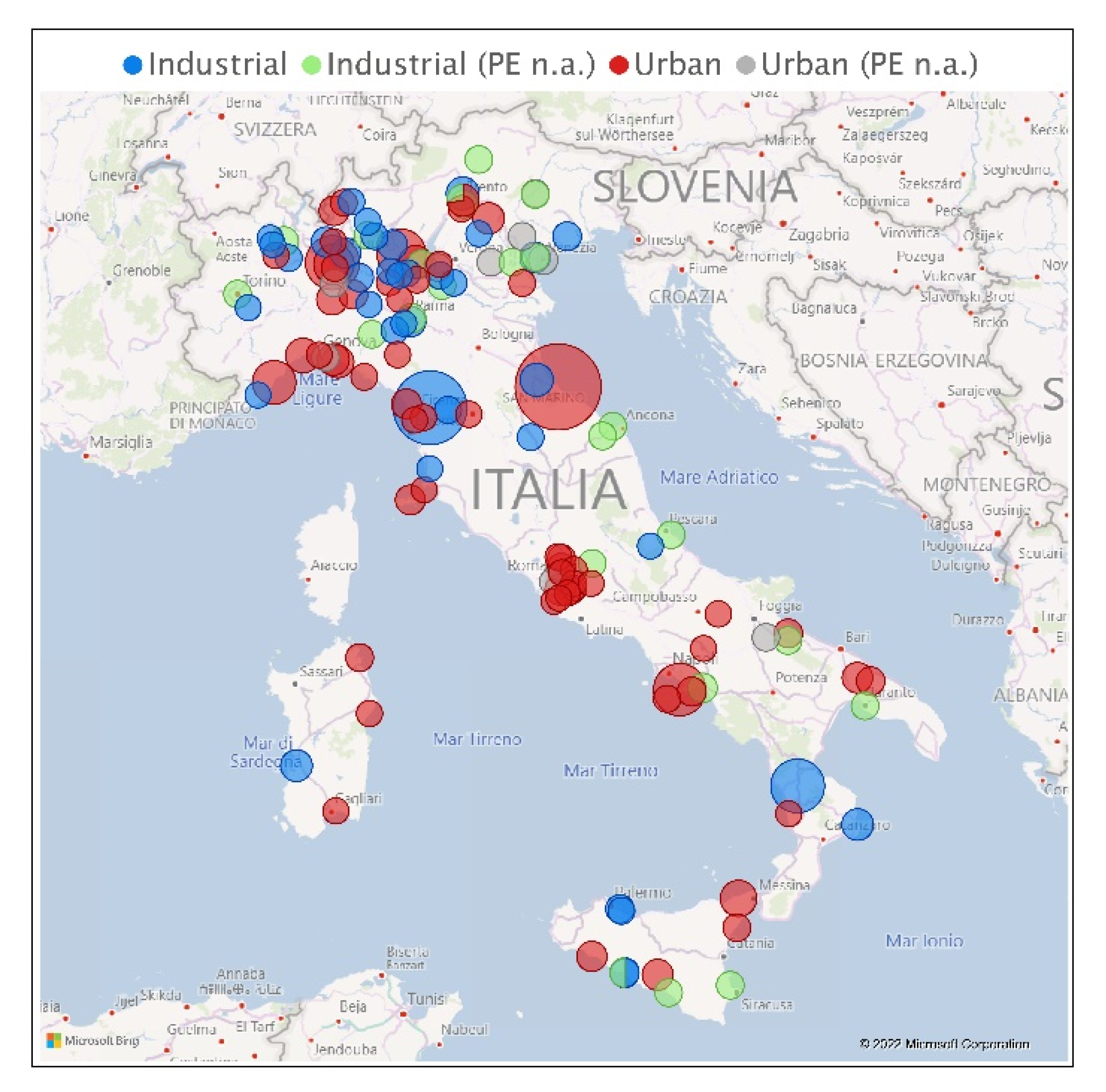
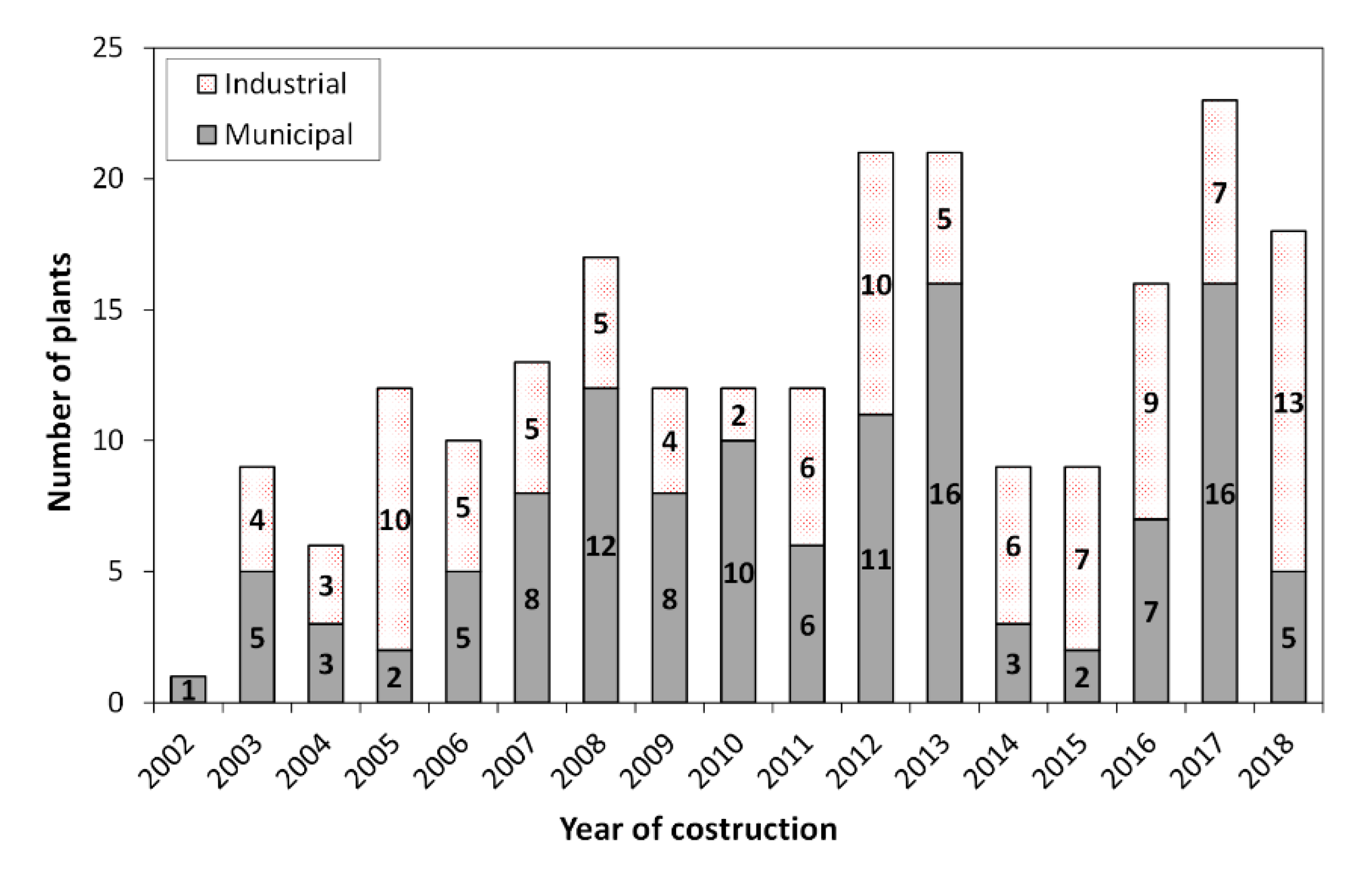
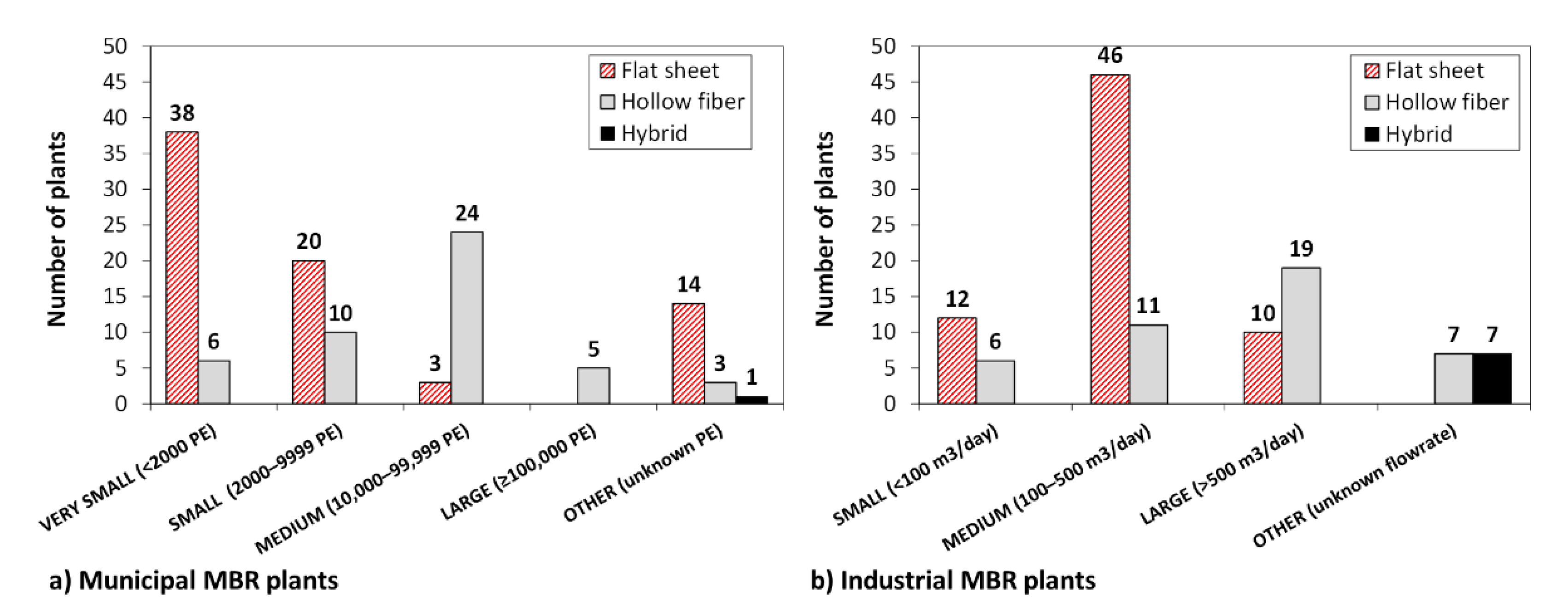
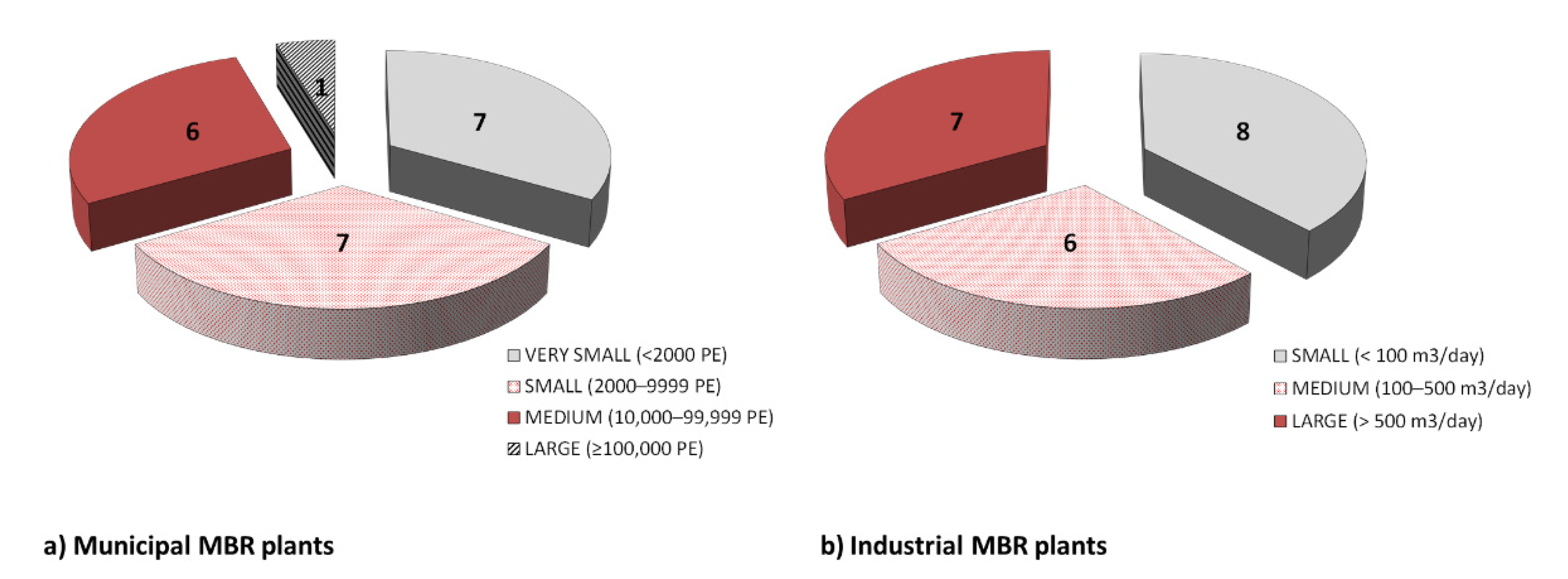
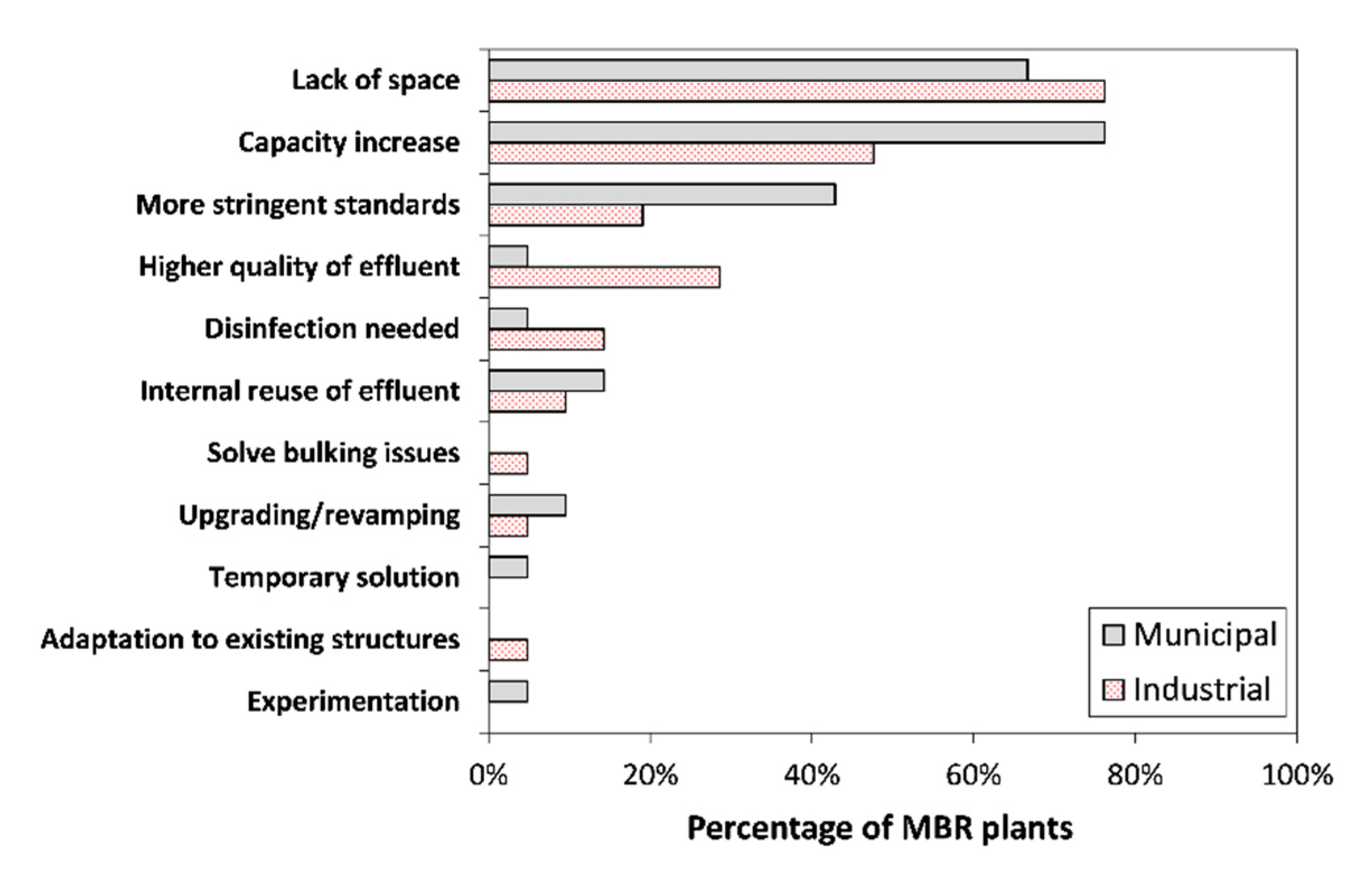
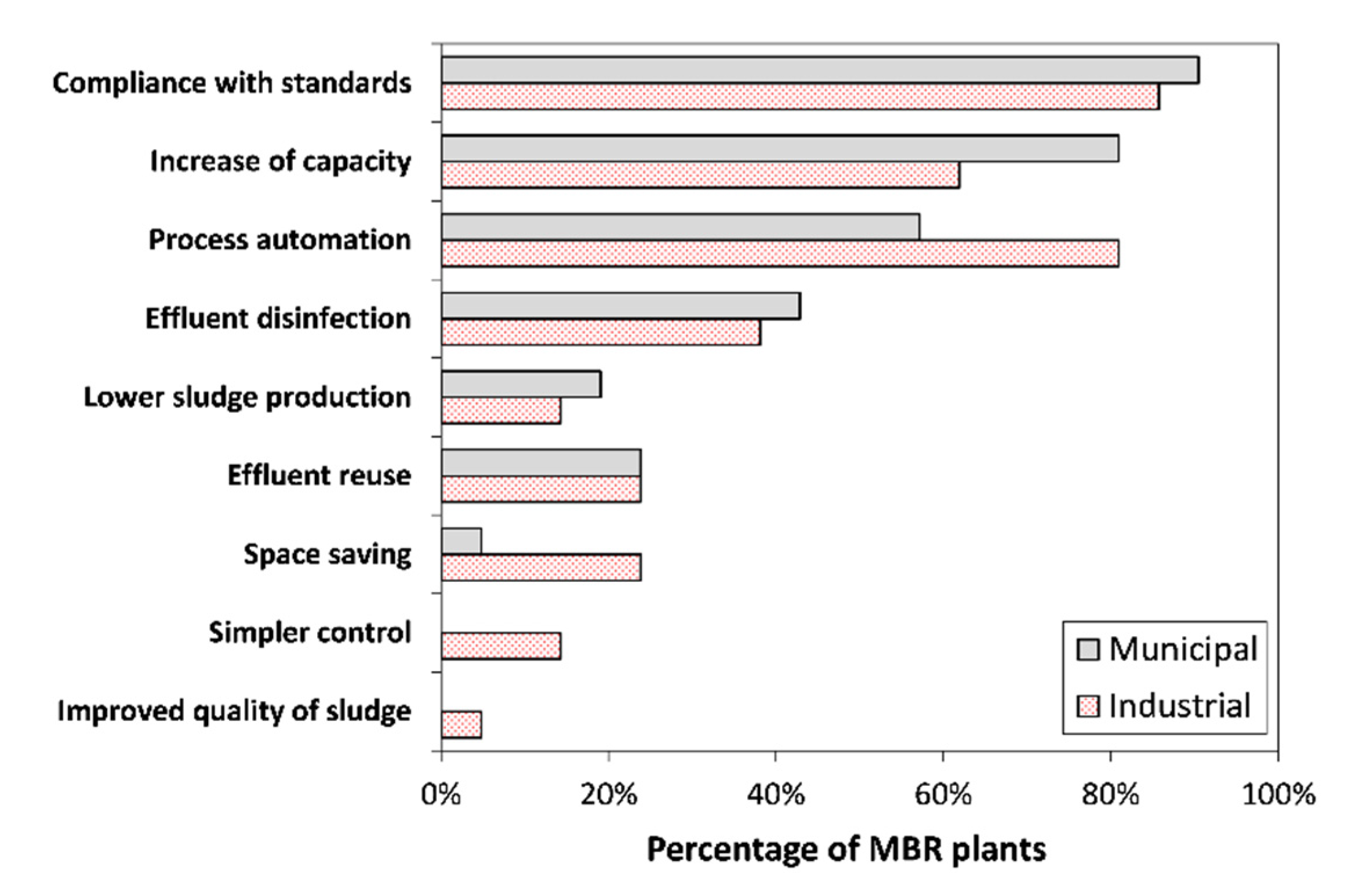

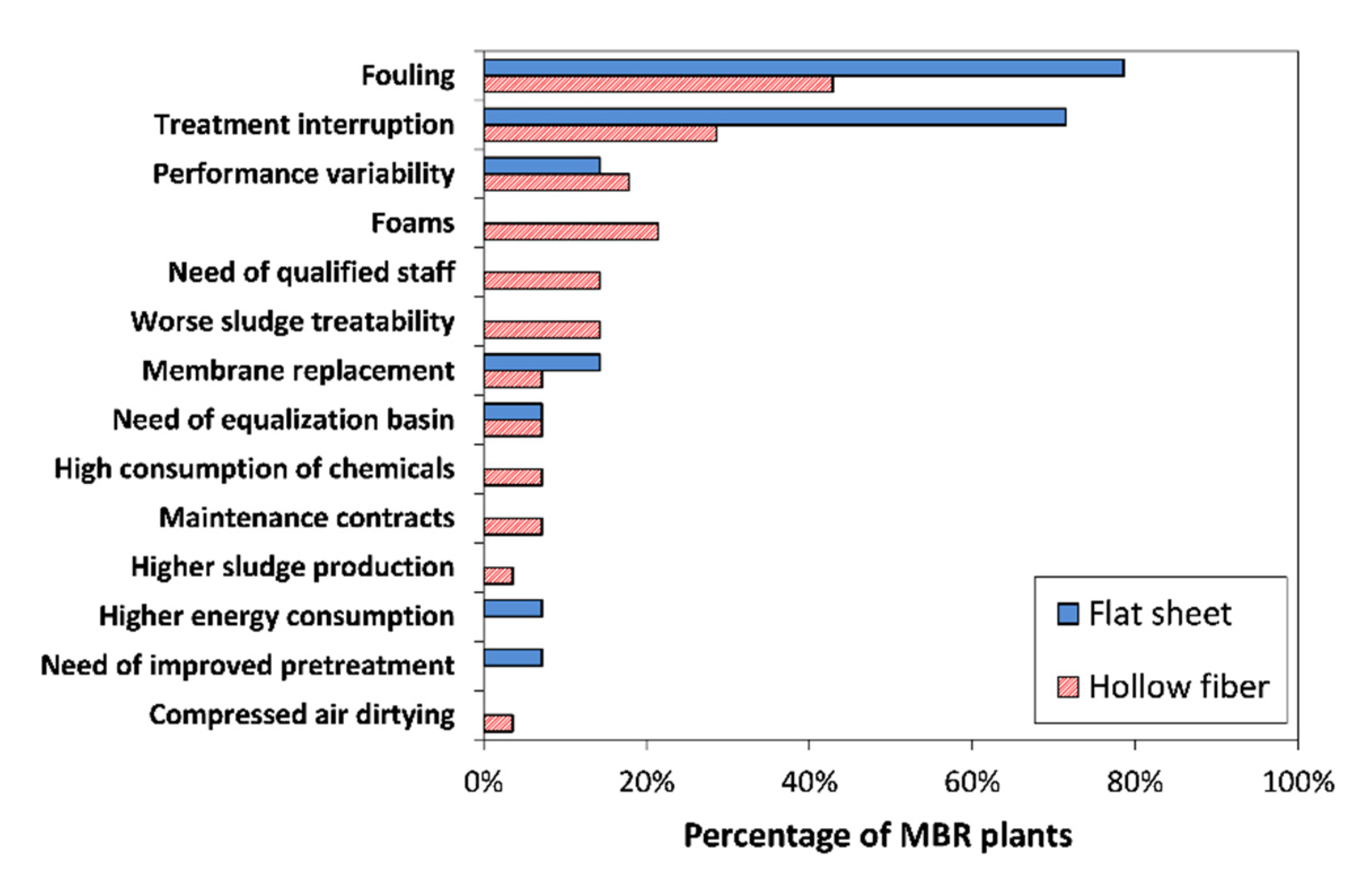
| CATEGORY (Capacity-PE) | MBR Installation | Capacity | ||
|---|---|---|---|---|
| Number of Plants | [%] | [PE] | [%] | |
| VERY SMALL (<2000) | 44 | 42 | 40,742 | 2 |
| SMALL (2000–9999) | 30 | 28 | 151,164 | 8 |
| MEDIUM (10,000–100,000) | 27 | 25 | 793,453 | 39 |
| LARGE (≥100,000) | 5 | 5 | 1,040,000 | 51 |
| TOTAL | 106 | 100 | 2,025,359 | 100 |
| CATEGORY (Flowrate-m3/Day) | MBR Installation | |
|---|---|---|
| Number of Plants | [%] | |
| SMALL (<100) | 18 | 17 |
| MEDIUM (100–500) | 57 | 55 |
| LARGE (≥500) | 29 | 28 |
| TOTAL | 104 | 100 |
| Industrial MBR Plant | Treatment Train * | Effluent Destination |
|---|---|---|
| #1 | Flot → Coag/Flocc → Nit → Den → MF | Water body |
| #2 | FS (1.5 mm) → Equal → Den → Nit → MF | Water body |
| #3 | FS (3 mm) → Neutral → Bio ox → MF | Water body |
| #4 | FS (1 mm) → Equal → Flot → Bio ox → MF | Water body |
| #5 | FS → Equal → Bio ox → MF | Sewer |
| #6 | FS (1.5 mm) → Flot → Equal → Bio ox → MF | Water body/reuse |
| #7 | FS → G/F rem → Den → Nit → MF | Water body |
| #8 | FS (1 mm) → Equal → Neutr → Bio ox → MF | Sewer |
| #9 | FS (1 mm) → Equal → Neutr → Bio ox → MF | Water body/reuse |
| #10 | FS (1 mm) → Equal → Neutr → Bio ox → MF | Water body/reuse |
| #11 | FS (3 mm) → Equal → Neutr → Flot → Bio ox → MF | Water body/reuse |
| #12 | FS (1 mm) → Equal → Bio ox → MF | Soil/subsoil |
| #13 | FS (1 mm) → G/F rem → Equal → Bio ox → MF | Soil/subsoil |
| #14 | FS (1 mm) → G/F rem → Den → Nit → P rem → MF | Soil/subsoil |
| #15 | Equal → Neutr → Flot → Nit → Den → MF | Water body |
| #16 | FS (2 mm) → Equal → Flot → Den → Nit → MF | Sewer |
| #17 | Neutr → Flot → Bio ox → MF | Water body |
| #18 | CS → FS → Flot → Bio ox → MF | Water body |
| #19 | Equal → FS(1mm) → Den → Nit → MF | Water body |
| #20 | FS (2 mm) → Sed → Nit/Den → MF | Sewer |
| #21 | Equal → Coag/Flocc → Sed → Bio ox → MF | Sewer |
Publisher’s Note: MDPI stays neutral with regard to jurisdictional claims in published maps and institutional affiliations. |
© 2022 by the authors. Licensee MDPI, Basel, Switzerland. This article is an open access article distributed under the terms and conditions of the Creative Commons Attribution (CC BY) license (https://creativecommons.org/licenses/by/4.0/).
Share and Cite
Vaccari, M.; Abbà, A.; Bertanza, G.; Collivignarelli, C. An Evidence-Based Survey on Full-Scale Membrane Biological Reactors: Main Technical Features and Operational Aspects. Appl. Sci. 2022, 12, 6559. https://doi.org/10.3390/app12136559
Vaccari M, Abbà A, Bertanza G, Collivignarelli C. An Evidence-Based Survey on Full-Scale Membrane Biological Reactors: Main Technical Features and Operational Aspects. Applied Sciences. 2022; 12(13):6559. https://doi.org/10.3390/app12136559
Chicago/Turabian StyleVaccari, Mentore, Alessandro Abbà, Giorgio Bertanza, and Carlo Collivignarelli. 2022. "An Evidence-Based Survey on Full-Scale Membrane Biological Reactors: Main Technical Features and Operational Aspects" Applied Sciences 12, no. 13: 6559. https://doi.org/10.3390/app12136559








